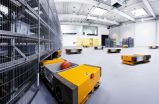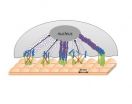(Press-News.org) The orange-colored vehicle begins moving with a quiet whirr. Soon afterwards the next shuttles begin to move, and before long there are dozens of mini-transporters rolling around in the hall. As if by magic, they head for the high-rack storage shelves or spin around their own axis. But the Multishuttle Moves® – is the name given to these driverless transport vehicles – are not performing some robots' ballet. They are moving around in the service of science. At the Fraunhofer Institute for Material Flow and Logistics IML in Dortmund, Germany, researchers are working to harness swarm intelligence as a means of improving the flow of materials and goods in the warehouse environment. In a research hall 1000 square meters in size, the scientists have replicated a small-scale distribution warehouse with storage shelves for 600 small-part carriers and eight picking stations. The heart of the testing facility is a swarm of 50 autonomous vehicles. "In the future, transport systems should be able to perform all of these tasks autonomously, from removal from storage at the shelf to delivery to a picking station. This will provide an alternative to conventional materials-handling solutions," explains Prof. Dr. Michael ten Hompel, executive director at IML.
But how do the vehicles know what they should transport, and where, and which of the 50 shuttles will take on any particular order? "The driverless transport vehicles are locally controlled. The ›intelligence‹ is in the transporters themselves," Dipl.-Ing. Thomas Albrecht, head of the Autonomous Transport Systems department explains the researchers' solution approach. "We rely on agent-based software and use ant algorithms based on the work of Marco Dorigo. These are methods of combinational optimization based on the model behavior of real ants in their search for food." When an order is received, the shuttles are informed of this through a software agent. They then coordinate with one another via WLAN to determine which shuttle can take over the load. The job goes to whichever free transport system is closest.
The shuttles are completely unimpeded as they navigate throughout the space – with no guidelines. Their integrated localization and navigation technology make this possible. The vehicles have a newly developed, hybrid sensor concept with signal-based location capability, distance and acceleration sensors and laser scanners. This way, the vehicles can compute the shortest route to any destination. The sensors also help prevent collisions.
The vehicles are based on the components of the shelf-bound Multishuttle already successfully in use for several years. The researchers at IML have worked with colleagues at Dematic to develop the system further. The special feature about the Multishuttle Move®: the transporters can navigate in the storage area and in the hall. To accomplish this, the shuttles are fitted with an additional floor running gear. But what benefits do these autonomous transporters offer compared with conventional steady materials-handling technology with roller tracks? "The system is considerably more flexible and scalable," Albrecht points out. It can grow or contract depending on the needs at hand. This is how system performance can be adapted to seasonal and daily fluctuation.
Another benefit: It considerably shortens transportation paths. In conventional storage facilities, materials-handling equipment obstructs the area between high-rack storage and picking stations. Packages must travel two to three times farther than the direct route. "It also makes shelf-control units and steady materials-handling technology," Albrecht adds. Researchers are now trying to determine how these autonomous transporters can improve intralogistics. "We want to demonstrate that cellular materials-handling technology makes sense not only technically but also economically as an alternative to classic materials-handling technology and shelf-control units," institute executive director ten Hompel observes. If this succeeds, the autonomous vehicles could soon be going into service in warehouses.
INFORMATION:
Swarming and transporting
2012-03-26
ELSE PRESS RELEASES FROM THIS DATE:
Who knew? Fruit flies get kidney stones too, may hold key to treatment for humans
2012-03-26
ROCHESTER, Minn. -- Research on kidney stones in fruit flies may hold the key to developing a treatment that could someday stop the formation of kidney stones in humans, a team from Mayo Clinic and the University of Glasgow found. They recently presented their findings at the Genetics Society of America annual meeting.
"The kidney tubule of a fruit fly is easy to study because it is transparent and accessible," says physiologist Michael F. Romero, Ph.D., of Mayo Clinic in Rochester, Minn. He said researchers are now able to see new stones at the moment of formation.
"More ...
Expectations, exhaustion can lead mothers to post-adoption stress
2012-03-26
WEST LAFAYETTE, Ind. - Fatigue and unrealistic expectations of parenthood may help contribute to post-adoption depression in women, according to a Purdue University study.
"Feeling tired was by far the largest predictor of depression in mothers who adopted," said Karen J. Foli, an assistant professor of nursing who studied factors that could predict depression in adoptive mothers. "We didn't expect to see this, and we aren't sure if the fatigue is a symptom of the depression or if it is the parenting experience that is the source of the fatigue. It also may be reflective ...
Brain insulin resistance contributes to cognitive decline in Alzheimer's disease
2012-03-26
PHILADELPHIA – Insulin resistance in the brain precedes and contributes to cognitive decline above and beyond other known causes of Alzheimer's disease, according to a new study by researchers from the Perelman School of Medicine at the University of Pennsylvania. Insulin is an important hormone in many bodily functions, including the health of brain cells. The team identified extensive abnormalities in the activity of two major signaling pathways for insulin and insulin-like growth factor in non-diabetic people with Alzheimer's disease. These pathways could be targeted ...
Research sheds new light on extra help for smokers trying to quit
2012-03-26
A major research trial to test whether extra support for smokers calling an NHS quitline - on top of what is already offered by the service - has found the additional help does not improve success rates for quitting the habit.
The pilot scheme offered smokers additional help in the form of free nicotine patches and extra telephone counselling from the English National Quitline. The Department of Health and UK Centre for Tobacco Control Studies (UKCTCS)-funded study led by The University of Nottingham's UK Centre for Tobacco Control Studies has just been published in the ...
Non-narcotic pain medication is safe and effective after sinus surgery
2012-03-26
MAYWOOD, Il. -- Patients who have undergone sinus surgery can safely take an alternative pain medication that does not cause the side effects of narcotics such as fentanyl and Vicodin, a Loyola University Health System study has found.
The alternative medication is ketorolac (brand name, Toradol). It is in the same class of nonsteroidal anti-inflammatory drugs as Advil and Aleve. Ketorolac does not cause the side effects that narcotic drugs cause, such as itching, nausea, vomiting, constipation and drowsiness, said Kevin Welch, MD, corresponding author of the study, published ...
Identifying acute myeloid leukemia gene mutations may indicate risk, best treatment
2012-03-26
TAMPA, Fla. – An international group of researchers, including those from Moffitt Cancer Center in Tampa, Fla., have published a paper in the March 14 issue of the New England Journal of Medicine reviewing the results of a study that analyzed mutations in 18 genes of 398 patients who had acute myeloid leukemia (AML). They found that several mutated genes predicted improved outcomes when patients with certain gene mutations were given high-dose induction chemotherapy. Their findings suggest that mutational profiling could potentially be used for both risk stratification ...
Marine forensics expert Richard Woytowich seeks to vindicate Titanic survivors' account
2012-03-26
Brooklyn, NY -- On the eve of the 100th anniversary of the Titanic's sinking, marine forensics expert Richard Woytowich will present a paper re-interpreting the statements made by survivors at the 1912 official inquiries into the disaster.
Woytowich, a professor of computer engineering technology at New York City College of Technology (City Tech), will take into account what engineers and other technologists now know about how the ill-fated passenger liner broke apart on April 15, 1912. He will be presenting his research on April 4, 8 a.m., at the International Marine ...
A new test might facilitate diagnosis and drug development for Alzheimer's disease
2012-03-26
An international team of researchers have developed a new method for measurement of aggregated beta-amyloid – a protein complex believed to cause major nerve cell damage and dysfunction in Alzheimer's disease. The new method might facilitate diagnosis and detection as well as development of drugs directed against aggregated beta-amyloid.
Alzheimer's disease (AD) is the most common cause of memory decline and dementia. According to the Alzheimer World Report 2011, today around 36 million people suffer from Dementia (around 20 - 25 million are Alzheimer's patients). These ...
New ORNL tool developed to assess global freshwater stress
2012-03-26
A new method to make better use of vast amounts of data related to global geography, population and climate may help determine the relative importance of population increases vs. climate change.
While several recent studies suggest that much of the world is likely to experience freshwater shortages as the population increases and temperatures rise, determining the relative impact of each has been difficult. An Oak Ridge National Laboratory paper published in Computers & Geosciences outlines a process that might help.
"Our work establishes a new method to couple geographic ...
'Bed-of-nails' breast implant deters cancer cells
2012-03-26
PROVIDENCE, R.I. [Brown University] -- One in eight women in the United States will develop breast cancer. Of those, many will undergo surgery to remove the tumor and will require some kind of breast reconstruction afterward, often involving implants. Cancer is an elusive target, though, and malignant cells return for as many as one-fifth of women originally diagnosed, according to the American Cancer Society.
Would it be possible to engineer implant materials that might drive down that rate of relapse? Brown University biomedical scientists report some promising advances. ...


